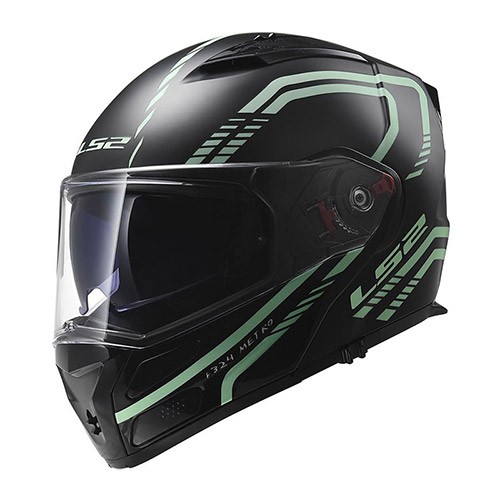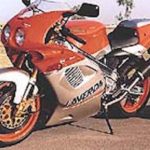[GTranslate]
Laverda, in Italian, means “wash your hands,” and that’s what Piaggio did after it acquired the small Breganze brand circa 2000 – washed its hands of the entire brand. (Piaggio bought Moto Guzzi at the same time.) Seven years earlier, though, one Francesco Tognon had bought the brand and produced the bikes you see here, based around an updated 668cc version of a pre-existing parallel twin. Some brave people from Texas, Laverda USA!, brought some bikes to California for the motorcycle press to crash. Why not? They were expendable.
There exists a generation gap among motorcyclists. Doubt us? Find two enthusiasts and play the Motorcycle Online Word Association Game.One contestant should be over 40, the other under 30. The category: Famous European Manufacturers. First, ask the 40-year-old what is the first thing that comes to mind after hearing “Bultaco” and he’ll probably mutter something about a famous Spanish off-road motorcycle. Say Bultaco to the 20-year-old and he’ll ask you if that comes with chips and salsa.
Now, say Laverda and the 40-something might begin to wax sentimental about racing championships and 1200 Jotas of yore. Say Laverda to the 20-something and if there’s a hint of recognition on his face it will be because his dad used to race them. His knowledge of Laverdas likely goes no deeper than the thickness of the decals on his bold-new-graphics Gixxer.
In the USA, Laverdas do not receive much notice or press because there’s very little racing activity from their camp. But Laverda feels that it’s about time the American press and public took a harder, more serious look at what they have to offer because, they feel, it’s as good as any Italian bike available today.
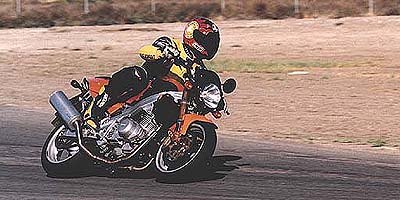 |
To prove their point, Laverda USA trucked in a few bikes from their Houston, Texas homestead for a day of track fun at the Buttonwillow Raceway, just northwest of Bakersfield, CA. They invited a number of scribes from the motorcycle press to sample their new Strike 750, Café Racer 750 and the 750S Formula. Also on hand were three of their race bikes which are designed to compete in the new AHRMA/Laverda National Challenge Series; one was a 668, the other two were 750-based racers also eligible for next year’s AMA Pro Thunder class.
Tech Breakdown
On paper, the Strike 750 is Laverda’s price-point, entry-level ride; but it’s not, by any means, a boring, standard ride. Most notably changed this year is the headlamp which is now a single projector-beam unit. Last year’s twin headlamp, and cowl will be offered as optional equipment. Striking orange paint covers beautiful, minimalist bodywork that accentuates an aluminum beam-type frame and a removable rear subframe. The swingarm is also aluminum and, when measured from stem to stern, the wheelbase registers 54.13 inches on the factory’s tape-measure. What appears to be the gas tank is nothing more than an airbox cover since the fuel is carried in a plastic tank that resides under the rear-section of the bike, helping to keep the center of gravity low.
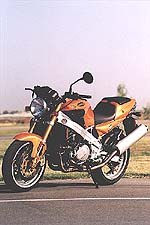 750 Strike
750 StrikeProviding the power for this machine is Laverda’s own Weber-Marelli fuel injected DOHC, eight-valve, liquid-cooled 747cc, parallel twin they claim produces 85 hp at the crank. The engine is mated to a six-speed tranny that, when pushing around just 418 pounds claimed dry weight, makes for plenty of propulsion. Other chassis niceties include dual Brembo disc brakes up front employing four-piston calipers and semi-floating 320mm discs, a fully-adjustable Paioli rear shock, a 41mm inverted fork and Marchesini three-spoke rims.Built on the Strike platform, the 750 Café Racer differs from its orange sibling in a few ways which make it appealing to the more sport-inclined rider. The black beauty weighs in at 412 pounds, mostly due to the addition of a two-into-one Termignoni carbon fiber exhaust system that, when paired with the other upgrades, boosts power across the board. The compression ratio is raised by one point to 11.5:1, hotter camshafts are employed along with larger valves, and a new EFI management chip offers up a claimed 92 hp at the crank. Other changes include lower, fully-adjustable clip-ons, rear-set pegs, five-spoke Marchesini wheels and Metallic Black paint.
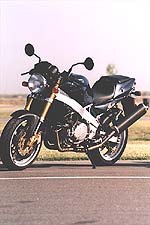 750 Cafe Racer
750 Cafe RacerDrawing back to Laverda’s full-on sportbike heritage is the full-faired 750S Formula. This bike is also built around the same basic platform as the other two more scantily-clad models, with its powertrain and chassis set-up similar to that of the 750 Cafe Racer. Differences include a polished swingarm and frame, full-floating front discs, externally adjustable fork preload, adjustable billet aluminum rearsets, adjustable front brake and clutch perches and a two-into-two Termignoni carbon fiber exhaust system. Wrapped in either Orange/Pearl Metallic Gray or Orange/Metallic Mediterranean Blue, the Formula offers up the same competent package as the Café Racer but with even racier accouterments, all wrapped in attractive bodywork.
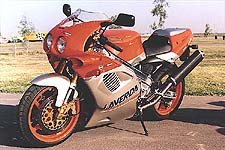 750S Formula
750S FormulaThe brakes worked wonderfully when slowing down for corners, providing excellent feel and stopping power. But track duty is not what this bike was designed for, and as the laps wore on and the tires heated up and scrubbed in, a few parts started to drag along with our knees. Still, the only complaint we could muster about the Strike is that something caused the throttle response to be just a touch sluggish, but Laverda’s engineers chalked that up to the wrong chip in the EFI system from earlier testing with a different exhaust system.
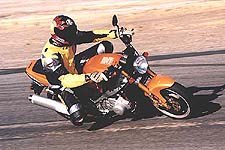 750 Strike handles better than a “standard” should.
750 Strike handles better than a “standard” should.At these elevated track speeds we yearned for something with a more sport-oriented riding position and a bit more motor. So we brought the Café Racer to life and immediately we were tuned into the sound of the Termignoni carbon fiber exhaust. Just pulling out of the pits and onto the track, before we even had a chance to wind the throttle on hard out of a slow corner, the added power was readily apparent. On the track, the added oomph was obvious and, with the changes in handlebar and footpeg position, we took a more aggressive attitude towards the track. The bike’s chassis remained unchanged, and it retained the same great handling manners and braking of the standard 750 Strike. Since the racier riding position put more weight on the front end, we could carry extra speed through the corners and, when combined with more power on tap, the stock tires left black stripes at most corner exits. For the street the Strike is a better choice with its more upright seating position and mellower motor. For serious work in the twisties, the Café Racer simply looks and feels better suited, and the sound, the modifications, and the sultry metallic black paint combine to make this the mount of choice for sunny Sunday mornings on your favorite road.
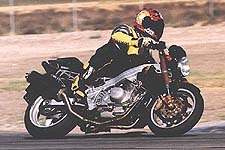 750 Cafe Racer off to hunt Monsters.
750 Cafe Racer off to hunt Monsters.Unfortunately, someone high-sided the 750 Formula on only it’s second lap. He thought the tires were warm — they were not — and as he rolled on the throttle over a rise, the back end came around then caught, launching both bike and rider into the air then hard onto the pavement. The rider walked away, although he was now the not-so-proud owner of a broken collarbone and a heavy chunk of guilt on his busted shoulder. Of course, this meant we would not be able to give a first-hand riding impression of the Formula. However, judging by the performance of the Café Racer, we figure that by wrapping the wonderful package in more slippery bodywork and adding a few other race-inspired features at the expense of only an additional four-pounds, the bike is sure to turn heads of onlookers and give riders wide grins.
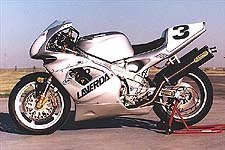 750-based racer for AHRMA and AMA Pro Thunder Series.
750-based racer for AHRMA and AMA Pro Thunder Series.In all, Laverda USA seems to have a pretty solid line-up for the new Millennium. Yet, the factory acknowledges that a Laverda is not for everyone. It’s more of an enthusiast’s bike. This doesn’t mean the bikes are quirky, however, nor does it mean you’ll need a best friend who is a mechanic to go along with a fat wallet. All new Laverda motorcycles will come with two-year, unlimited-mileage warranties when they hit dealer showrooms at the end of this year. And, with MSRPs of $8,495 USD for the Strike, $8,995 for the Café Racer and $10,595 for the Formula, the prices, as well as the bikes, are right in line with what other Italian manufacturers have to offer. Maybe better, even.
